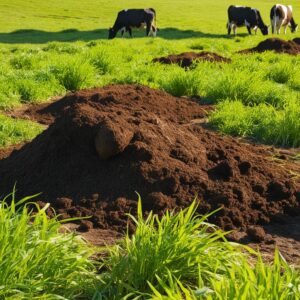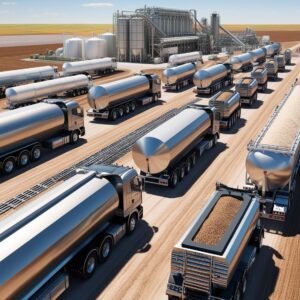Why is Fertilizer Expensive? Isn’t it Just Poop?

You’re right in a way—fertilizer does have a connection to organic waste products like manure, but the reasons fertilizers are expensive today go far beyond that.
While manure (often referred to as “poop”) is a natural source of fertilizer, commercial fertilizers—especially synthetic ones—are typically made from a variety of chemical processes and raw materials. Here’s why they’re so expensive:
Production Costs of Synthetic Fertilizers
Energy-Intensive Processes: The production of synthetic fertilizers, particularly nitrogen-based ones (like ammonium nitrate or urea), requires a significant amount of energy. A major part of the cost is the energy used to extract nitrogen from the air and combine it with hydrogen to make ammonia in a process called the Haber-Bosch process.
This process is very energy-hungry and requires natural gas as a key ingredient, which has become more expensive in recent years. (Sorry, the price for progress!)
Raw Material Costs: Other types of fertilizers, like phosphates and potassium, come from mining operations that are also capital- and labor-intensive. Phosphate mining, for instance, often requires large-scale extraction from rock deposits that are geographically concentrated in a few areas, and the price of these raw materials fluctuates based on supply and demand.
More than just poop!

Global Supply Chain and Transportation Costs
Fertilizer is a globally traded commodity, and its cost can be affected by factors like shipping prices, tariffs, and trade disruptions. Fertilizer often needs to be transported long distances, and fuel prices can play a large role in its final cost.
 Recent geopolitical tensions and supply chain disruptions (like those caused by the COVID-19 pandemic and the war in Ukraine) have led to significant price hikes in fertilizer.
Recent geopolitical tensions and supply chain disruptions (like those caused by the COVID-19 pandemic and the war in Ukraine) have led to significant price hikes in fertilizer.
At Jacquie’s Lawn care we know this about transportation cost and that is why we are local and take the time to have delivery and transportation costs run in smaller loads and batches!
Environmental and Regulatory Factors
The production and use of fertilizers are also subject to increasingly strict environmental regulations, which can raise costs. Fertilizer plants have to comply with laws around emissions, waste disposal, and water usage. This adds additional layers of cost to the production process.
We love the environment, without caring for it, we at Jacquie’s Lawn Care would be out of business, the care is worth the extra cost, and that is why we will price match any fertilizer on the market, and make a charitable donation to your charity of choice instead of making YOU pay the extra cost.
Supply and Demand Dynamics
- Increased Demand: As the global population grows and the need for higher crop yields intensifies, demand for fertilizers has risen. Agricultural industries, especially in developing countries, have expanded their use of fertilizers to increase food production, which drives up prices.
- Limited Sources: The global supply of some key raw materials for fertilizers, like phosphate rock, is finite and becoming harder to access. This can create price volatility based on scarcity.
- Sustainable Substitutes: The way to save on cost is to have sourced locally known alternatives that are organic and won’t harm our pets, communities or property. We pride ourselves at Jacquie’s Lawn Care to use sustainable sources as our #1 priority.
Fertilizer as a Chemical Product
While organic sources of fertilizer (like manure, compost, or bio-waste) are often seen as “cheap” in the traditional sense, they don’t always provide the same levels of nutrients or can be difficult to apply in the precise quantities needed for modern, large-scale farming. Fertilizers like nitrogen, phosphorus, and potassium are carefully formulated to meet the specific nutritional needs of crops, and the precision involved in producing these synthetic blends adds to their cost.
Sure, it’s possible to visit the nearby farm and get some poop, but typically that farmer doesn’t have it for sale in a compostable box and won’t deliver to the job. Jacquie’s Lawn Care, does the caring, and takes the fertilizer to your doorstep with every order.
So, while manure and other natural forms of fertilizer can be a cheap and sustainable option for some farms, modern synthetic fertilizers are expensive due to the energy costs, raw material extraction, transportation, regulatory hurdles, and global market conditions that affect their production. In short, it’s not just poop—it’s a complex, industrial process that requires significant resources, and those costs are passed on to the consumer.
Bag It and Carry On!
Most commercial fertilizers, both synthetic and organic, are sold in bags for easy transport and storage. The bags are usually made of plastic or paper and come in various sizes, from small 5- to 10-pound bags for home gardeners to large 50-pound or even 100-pound bags for agricultural use.
Traditional Bags:
In addition to traditional bags, some fertilizers also come in bulk or in liquid form, but the bagged version is by far the most common for both residential and small-scale commercial use. The bag often includes information like the nutrient composition (e.g., NPK ratio) and instructions for application.
Many customers do appreciate the convenience of being able to carry bags of fertilizer, especially when the bags are manageable in size. For home gardeners or smaller-scale buyers, having a bag that’s easy to transport and store is a key selling point.
People tend to feel more satisfied when they can easily handle and move products without requiring heavy lifting equipment or a lot of effort.
Smaller bags (e.g., 5- to 20-pound bags) are particularly popular because they’re lighter and can be carried without much hassle.
Pay it Forward Fertilizer Program: Supporting The Ronald McDonald House
Spreading the Word, and the Fertilizer
Knowing that fertilizer is more than “just poop” has prompted us to pick up any unused fertilizer and deliver to the next customer in our “Pay it Forward Fertilizer Program.”
Caring for not for profit facilities like our community “Ronald McDonald House” and “The Primary Children’s Hospital” means that your purchase will help others in our community experience a beautiful home away from home.
Thank you for your support and for paying it forward.